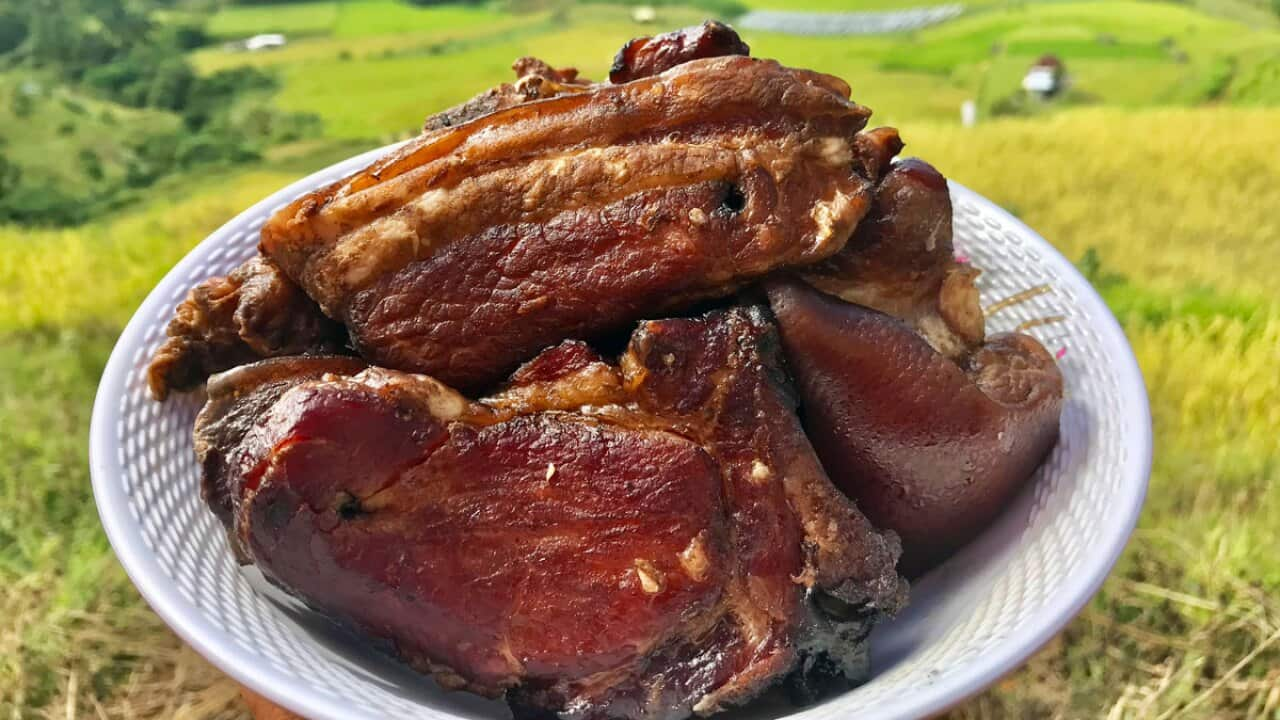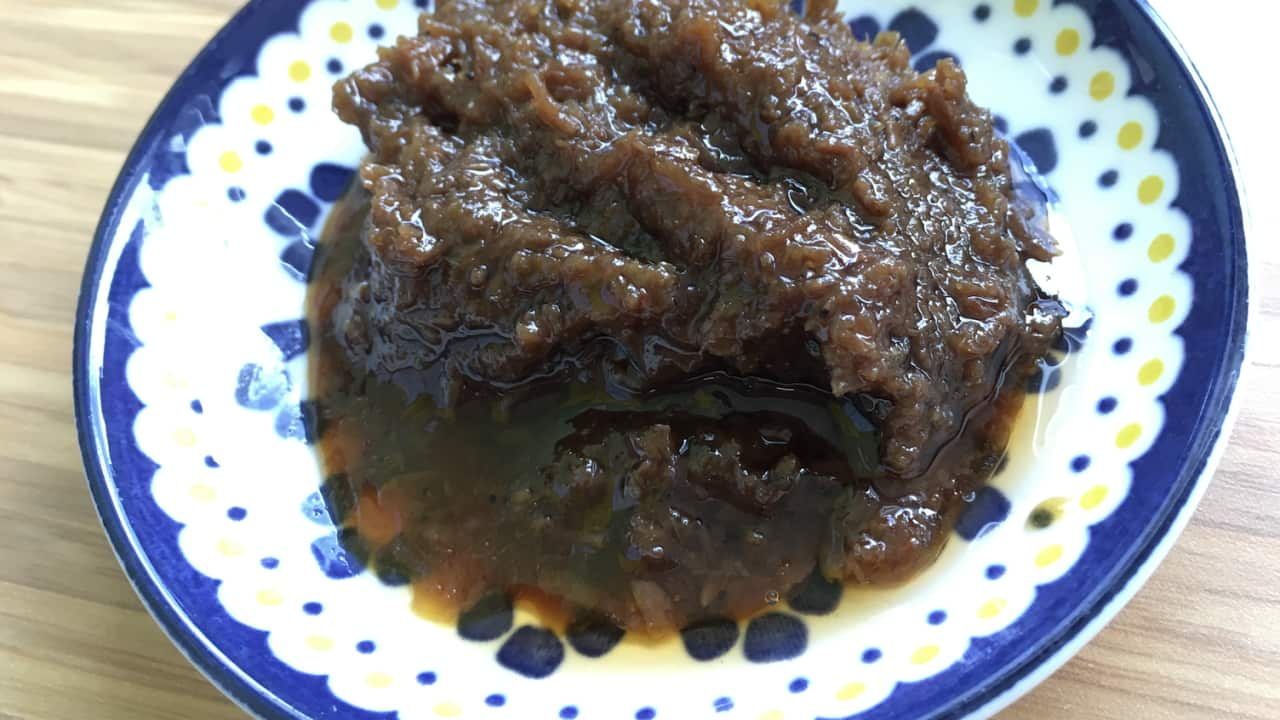When John Tubera made a clumsy first attempt at cooking tinumis, a regional variation of dinuguan (a pork blood stew from the Philippines), he knew who to call for help. "When I first came to Australia, I lived with a group of friends, and we were all craving dinuguan. I thought, 'I know how to cook it'," Tubera tells SBS Food.
"But it didn't really turn out nice… it was horrible. I called my mum, and said, 'Ma, I tried to cook your dinuguan, but it didn't come out like yours'," he recalls with a laugh.
Even from 6,000 kilometres away in the Philippines, John's mum Emerlita diagnosed the problem. John simply wasn't stewing the pork for long enough - the meat needed to simmer for longer than he had thought, until most of the fat had rendered. Only then should the pork blood be added.
"After this, when I tried to cook it, everyone loved it. My friends always ask me to cook dinuguan, especially here in Adelaide," says Tubera. "Whenever they want to come to our house, they ask, 'Are you going to cook the dinuguan? 'Cause if you're not gonna cook it, we're not gonna come'." This rich, spicy stew was one of the first dishes Emerlita taught Tuberas to make when he was growing up on their family farm in Cabanatuan in the Nueva Ecija province of the Philippines.
This rich, spicy stew was one of the first dishes Emerlita taught Tuberas to make when he was growing up on their family farm in Cabanatuan in the Nueva Ecija province of the Philippines.

It's important for John Tubera to stay connected to his homeland, which he does by cooking tinumis, a regional variation of dinuguan. Source: Nicole Wedding
The Tuberas had a rice mill and grew food to eat. The work was hard and the days were long, but dinner always invited everyone to slow down - even if just for a moment. "I think food is the one thing that can reunite us. When you cook some food, you need to stop whatever you're doing and just sit down," he says.
My friends always ask me to cook dinuguan, especially here in Adelaide. Whenever they want to come to our house, they ask, 'Are you going to cook the dinuguan? 'Cause if you're not gonna cook it, we're not gonna come'."
Feeling connected to his homeland is now more important than ever for Tubera. His longing for the Philippines has only grown during the pandemic, and he hasn't seen some of his family members in almost two years. Making dinuguan at , the Adelaide restaurant he owns with partner Denisse Hilario, is one small way he can feel closer to home. He makes it just like they do in Nueva Ecija - with tamarind and cubes of pork, rather than the vinegar or offal that is commonly associated with the dish. Tinumis is not the only variation of dinuguan in the Philippines. For instance, in the Bicol region, the dish includes coconut milk. Tubera speculates that dinuguan is widely eaten in the Philippines because pig is already used in popular dishes like lechon, a roasted suckling pork dish, so why not also use its blood.
Tinumis is not the only variation of dinuguan in the Philippines. For instance, in the Bicol region, the dish includes coconut milk. Tubera speculates that dinuguan is widely eaten in the Philippines because pig is already used in popular dishes like lechon, a roasted suckling pork dish, so why not also use its blood.

Adelaide chef John Tubera with his partner Denisse Hilario and their children. Source: Nicole Wedding
"When you cook [lechon], there's intestines that you need to take out. So instead of wasting it, people get the blood and organs from the pork, and cook dinuguan. So every time you order that dish in the Philippines, you're always going to get dinuguan on the side, too."
Lechon doesn't automatically come with a side of dinuguan at Juan Kusinero - Tubera and Hilario think it might not be the most accessible dish for those new to Filipino cuisine. However, they encourage people to try it.
Tubera's career has taken him to different kitchens across the country, but now, he feels it's time to share the food he eats at home. And the city is better for it.
Pork blood stew (tinumis or Nueva Ecija dinuguan)
Serves 6
Ingredients
- 3 tbsp cooking oil
- 10 cloves garlic, chopped
- 1 medium onion, diced
- 2 kg pork, cut into small cubes
- 4 tbsp fish sauce
- 200 g tamarind leaves, chopped
- 500 ml pork blood
- 1 cup fresh tamarind juice (can be substituted with powder or paste)
- ½ cup vinegar
- 4 long green chillies
- 1 tbsp ground black pepper
Method
1. Heat oil in a pan.
2. Saute garlic until it turns medium brown.
3. Add onion and saute until soft.
4. Add pork and cook until some of the fat has been rendered.
5. Add fish sauce and tamarind leaves. Cook on medium heat and stir continuously for 5-8 minutes.
6. Add water so that it covers the pork. Simmer until the pork is tender (this may be when the water evaporates).
7. Add the pork blood and continue to cook on medium heat while stirring for 10 to 15 minutes.
8. Add the tamarind juice, vinegar, green chillies and 2 cups of water. Continue cooking for about 20 to 25 minutes.
9. Add ground black pepper.
10. Add more fish sauce to taste.
Note: Pork blood should be available from your local butcher, or in the freezer section of Asian groceries.










